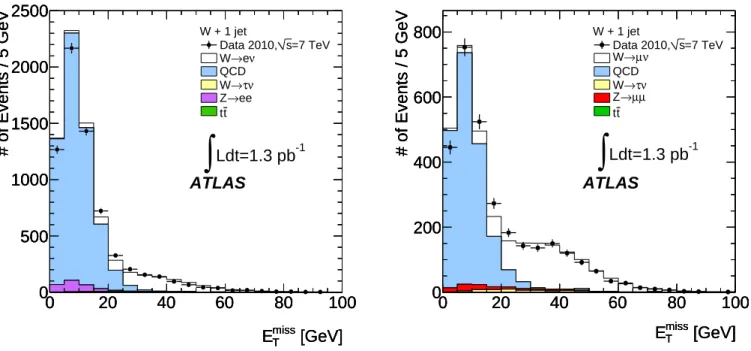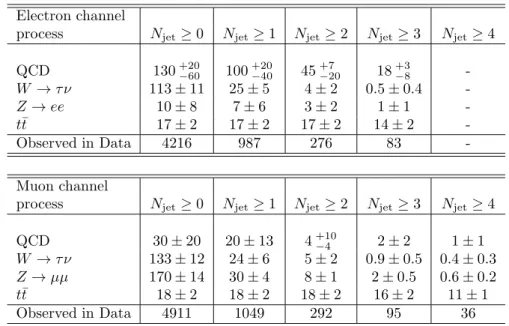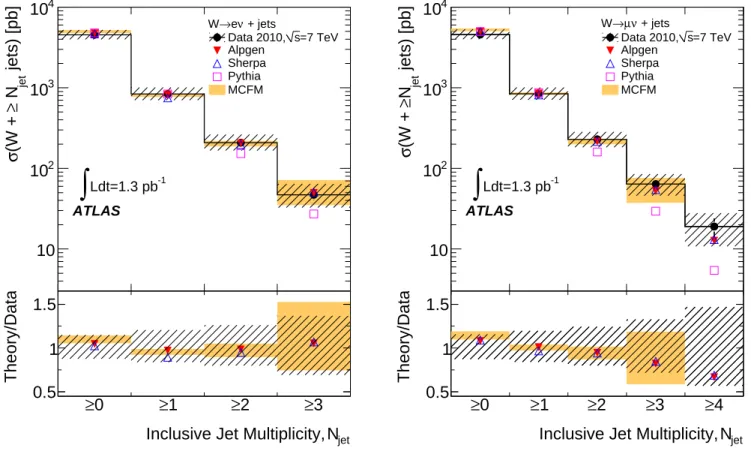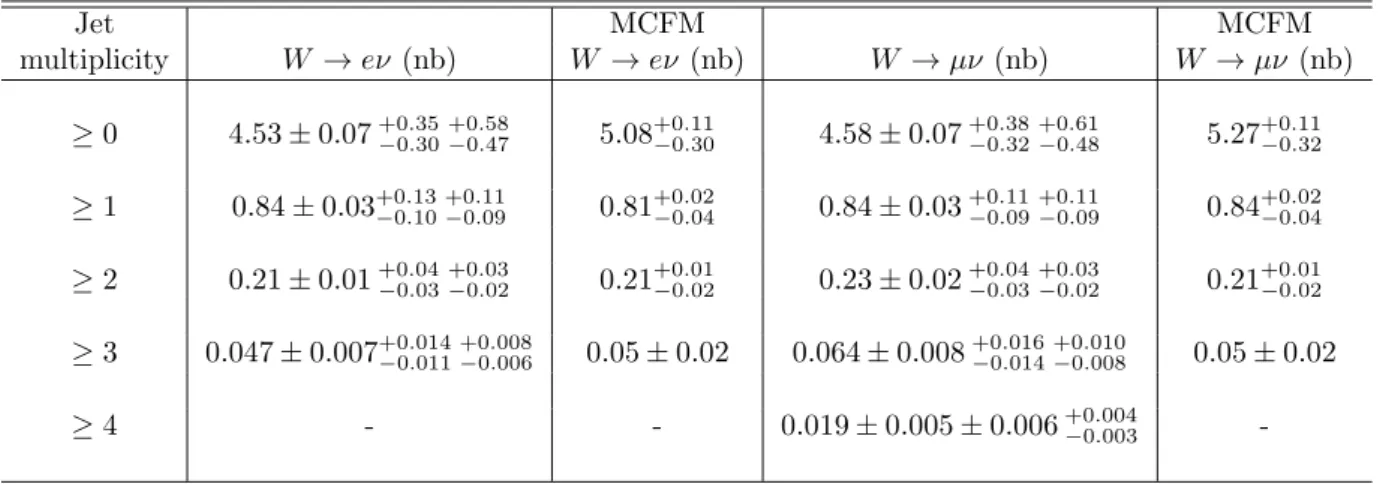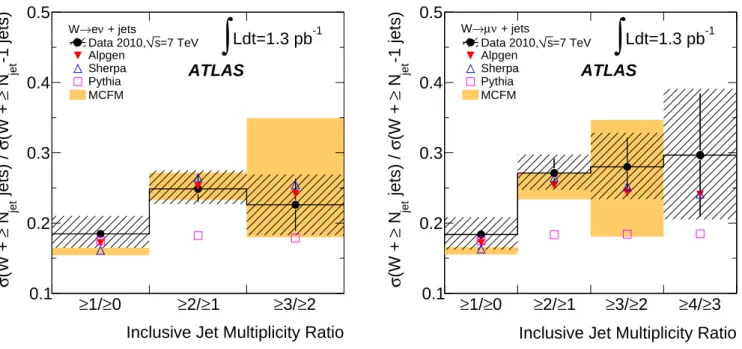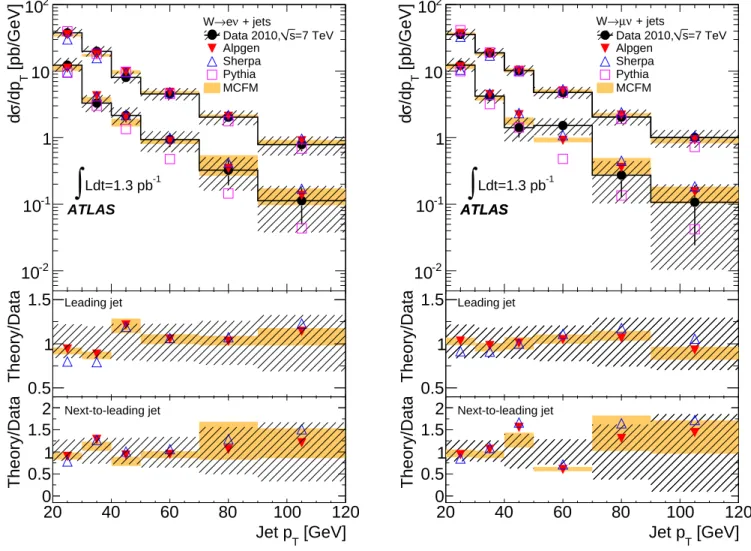arXiv:1012.5382v1 [hep-ex] 24 Dec 2010
EUROPEAN ORGANIZATION FOR NUCLEAR RESEARCH (CERN)
CERN-PH-EP/2010-081
Measurement of the production cross section for W-bosons in association with jets in pp collisions at √
s = 7 TeV with the ATLAS detector
The ATLAS Collaboration
Abstract
This Letter reports on a first measurement of the inclusiveW+jets cross section in proton-proton collisions at a centre-of- mass energy of 7 TeV at the LHC, with the ATLAS detector. Cross sections, in both the electron and muon decay modes of theW boson, are presented as a function of jet multiplicity and of the transverse momentum of the leading and next- to-leading jets in the event. Measurements are also presented of the ratio of cross sectionsσ(W+≥n)/σ(W+≥n−1) for inclusive jet multiplicities n= 1−4. The results, based on an integrated luminosity of 1.3 pb−1, have been corrected for all known detector effects and are quoted in a limited and well-defined range of jet and lepton kinematics. The measured cross sections are compared to particle-level predictions based on perturbative QCD. Next-to-leading order calculations, studied here for n ≤ 2, are found in good agreement with the data. Leading-order multiparton event generators, normalized to the NNLO total cross section, describe the data well for all measured jet multiplicities.
1. Introduction
The study of massive vector boson (V, where V =W or Z) production in association with one or more jets (V+jets) is an important test of quantum chromodynam- ics (QCD). In addition,V+jets processes are a significant background to studies of Standard Model processes such as t¯t or single-top production, as well as searches for the Higgs boson and for physics beyond the Standard Model.
Measurements of the cross section and kinematic prop- erties of V+jets processes and comparisons to theoretical predictions are therefore of significant interest. This Letter reports on a first measurement at the Large Hadron Col- lider (LHC) of theW+jets cross section in proton-proton (pp) collisions at a centre-of-mass energy (√
s) of 7 TeV, in both electron and muon decay modes of the W-boson, with the ATLAS detector. The measurement is based on an integrated luminosity of approximately 1.3 pb−1.
The cross section measurements are presented as a func- tion of jet multiplicity and of the transverse momentum (pT) of the leading and next-to-leading jets in each event.
Measurements are also presented of the ratio of cross sec- tions σ(W+≥ n)/σ(W+≥n−1) for inclusive jet mul-
tiplicities n = 1−4. The results have been corrected for all known detector effects and are quoted in a limited and well-defined range of jet and lepton kinematics, fully cov- ered by the detector acceptance, so as to avoid model- dependent extrapolations and to facilitate comparisons with theoretical predictions. Previous measurements ofW+jets production in proton-antiproton collisions at √
s = 1.96 TeV were published by the CDF Collaboration [1]. Theo- retical calculations at next-to-leading-order (NLO) in per- turbative QCD (pQCD) have been computed for up to four jets forW production [2, 3]. Comparisons are made in this Letter with NLO pQCD calculations forn≤2; higher jet multiplicities are compared only to leading-order (LO) cal- culations.
2. The ATLAS Detector
The ATLAS detector [4, 5] consists of an inner tracking system (inner detector, or ID) surrounded by a thin super- conducting solenoid providing a 2T magnetic field, electro- magnetic and hadronic calorimeters and a muon spectrom- eter (MS). The ID consists of pixel and silicon microstrip (SCT) detectors, surrounded by the transition radiation
tracker (TRT). The electromagnetic calorimeter is a lead liquid-argon (LAr) detector. Hadron calorimetry is based on two different detector technologies, with scintillator- tiles or LAr as active media, and with either steel, copper, or tungsten as the absorber material. The MS is based on three large superconducting toroids arranged with an eight-fold azimuthal coil symmetry around the calorime- ters, and a system of three stations of chambers for the trigger and for precise measurements. The nominalppin- teraction point at the centre of the detector is defined as the origin of a right-handed coordinate system. The posi- tivex-axis is defined by the direction from the interaction point to the centre of the LHC ring, with the positive y- axis pointing upwards, while the beam direction defines the z-axis. The azimuthal angle φ is measured around the beam axis and the polar angleθis the angle from the z-axis. The pseudorapidity is defined asη =−ln tan(θ/2).
3. Simulated Event Samples
Simulated event samples were used for most of the background estimates, for the correction of the signal yield for detector effects and for comparisons of the results to theoretical expectations. The detector simulation [6] was performed using GEANT4 [7]. The simulated event sam- ples are summarised in Table 1. The ALPGEN samples were generated with the MLM matching scheme [8] and interfaced to HERWIG v6.510 [9] for parton shower and fragmentation processes and to JIMMY v4.31 [10] for un- derlying event simulation. Parton density functions (PDF) were: CTEQ6L1 [11] for the ALPGEN and SHERPA sam- ples, MRST 2007 LO∗[12] for PYTHIA, and MSTW2008 [13] for FEWZ [14]. For the POWHEG samples, the PDF set was CTEQ6.6M [15] for the NLO matrix element cal- culations, while CTEQ6L1 was used for the parton show- ering and underlying event via the POWHEG interface to PYTHIA. The radiation of photons from charged leptons was treated in HERWIG and PYTHIA using PHOTOS v2.15.4 [16]. TAUOLA v1.0.2 [17] was used for tau decays.
The underlying event tune was the ATLAS MC09 tune [18]
for the ALPGEN samples, PYTHIA inclusive vector boson production, and PYTHIA QCD samples. The POWHEG sample used the ATLAS MC09 tune with one parame- ter adjusted.1 The AMBT1 [19] tune was used for the PYTHIA W+jets samples. The samples generated with SHERPA used the default underlying event tune. Samples were generated with minimum bias interactions overlaid on top of the hard-scattering event in order to account for the multiple ppinteractions in the same beam crossing (pile- up) experienced in the data. The number of minimum bias interactions followed a Poisson distribution with a mean of two [20]. These samples were then reweighted such that the distribution of the number of primary vertices matched that of the data.
1The cutoff for multiple parton interactions, PARP(82), was ad- justed from 2.3 to 2.1 GeV, suitable for the CTEQ6L1 PDF.
4. Data and Event Selection
The data used in this analysis were collected from March to August 2010. Application of beam, detector, and data- quality requirements resulted in a total integrated lumi- nosity of 1.3 pb−1. The uncertainty on the luminosity determination is estimated to be 11% [26]. Criteria for electron and muon identification, as well as for event se- lection, followed closely those for the W boson inclusive cross section analysis [27].
In the electron channel, a hardware-based level-one trigger system selected events containing one or more elec- tron candidates, based on the presence of a cluster in the electromagnetic calorimeter with a transverse energy (ET) greater than 14 GeV; this is the only difference in the elec- tron channel with respect to the W inclusive cross sec- tion analysis, and was motivated by the fact that, for this larger dataset, this trigger was the lowest-threshold, useful electromagnetic trigger without any additional higher-level trigger requirements. The impact of the trigger efficiency was negligible for electrons with ET > 20 GeV. In the offline analysis, electrons were required to pass the stan- dard “tight” electron selection criteria [27] withET >20 GeV and|η|<2.47; electrons in the transition region be- tween the barrel and endcap calorimeter (1.37 < |η| <
1.52) were rejected. Events were also rejected if there was a second electron passing the “medium” electron selection criteria [27] and the same kinematic selections as above.
In the muon channel, the hardware-based trigger se- lected events containing one or more muon candidates, based on hit patterns in the MS, corresponding topT>10 GeV. Offline, the muons were required to be identified in both ID and MS subsystems and to havepT>20 GeV and
|η|<2.4. The ID track was required to have≥2 hits in the pixel detector, ≥ 6 hits in the SCT and, for tracks with |η| < 2.0, ≥ 1 hit in the TRT. The muon impact parameter with respect to the primary vertex [20] was re- quired to be < 0.1 mm and < 10 mm in the r−φ and r−z planes, respectively. The first of these requirements was added to further reduce non-prompt muons from de- cays of hadrons, and muons from cosmic rays. The differ- ence between the ID and MS pT, corrected for the mean energy loss in upstream material, was required to satisfy
|pIDT −pMST |<0.5×pIDT. Compared to the criteria used in Ref. [27], this scaled requirement reduced the background from decays-in-flight of hadrons and improved the signal efficiency at high pT. As in Ref. [27], the muons were required to be isolated, following a track-based isolation, but the cone size was reduced from ∆R= 0.4 to ∆R= 0.2 (where ∆R=p
(∆η)2+ (∆φ)2of the muon) and the iso- lation requirement was changed from ΣpIDT/pT < 0.2 to ΣpIDT <1.8 GeV to improve the QCD background rejec- tion. With these optimised cuts, the QCD background was reduced by a factor of 1.7 for the inclusive 1-jet sample.
In addition, a number of requirements were added on the tracks inside the isolation cone: the difference between the z position of the track extrapolated to the beam line and
Physics process Generator σ·BR (nb)
W →ℓν inclusive (ℓ=e, µ, τ) PYTHIA 6.4.21 [21] 10.46 NNLO [14]
W+→ℓ+ν 6.16 NNLO [14]
W−→ℓ−ν 4.30 NNLO [14]
W →ℓν + jets (ℓ=e, µ, τ) PYTHIA 6.4.21 [21]
W →ℓν + jets (ℓ=e, µ, τ, 0≤Nparton≤5) ALPGEN 2.13 [22]
W →ℓν + jets (ℓ=e, µ, τ, 0≤Nparton≤4) SHERPA 1.1.3 [23]
Z→ℓℓ+ jets (mℓℓ>40 GeV, 0≤Nparton≤5) ALPGEN 2.13 [22] 1.07 NNLO [14]
t¯t POWHEG-HVQ
v1.01 patch 4 [24] 0.16 NLO+NNLL [25]
Dijet (echannel, ˆpT>15 GeV) PYTHIA 6.4.21 [21] 1.2×106 LO [21]
Dijet (µchannel, ˆpT>8 GeV,pµT> 8 GeV) PYTHIA 6.4.21 [21] 10.6×106 LO [21]
Table 1: Signal and background simulated event samples used in this analysis, including the production cross section (multiplied by the relevant branching ratio, BR). The variable ˆpTis the averagepTof the two outgoing partons involved in the hard-scattering process, evaluated before modifications from initial- and final-state radiation and from the underlying event. TheW inclusive cross section is given at next-to-next- to-leading-order (NNLO), thett¯cross section is given at next-to-leading-order (plus next-to-next-to-leading-log, NNLL), and the dijet cross sections are given at leading-order (LO) in pQCD. TheW+jets andZ+jets samples were normalised using the inclusive cross sections. For PYTHIA, the inclusiveW sample is based on a 2→1 matrix element merged with a 2→2 matrix element and a leading-logarithmic parton shower; theW+jets samples are based on 2→2 matrix elements. Details of PDF sets, final-state photon radiation, and underlying event tunes are given in the text.
thezcoordinate of the primary vertex was required to be
<1 cm, and the total number of hits in the pixel and SCT detectors was required to be≥4. These additional require- ments further improved the rejection of QCD background.
Events were rejected if there was a second muon passing the same kinematic selections and isolation requirements as above.
The calculation of missing transverse energy (ETmiss) and transverse mass (MT) followed the prescription in Ref. [27]. MT was defined by the lepton and neutrino pT as MT =q
2pℓTpνT(1−cos(φℓ−φν)), where the (x, y) components of the neutrino momentum were inferred from the corresponding ETmiss components. ETmiss was calcu- lated from the energy deposits of calorimeter cells inside three-dimensional clusters [28]. These clusters were then corrected to take into account the different response to hadrons compared to electrons or photons, as well as dead material and out-of-cluster energy losses [29]. In the muon channel, ETmiss was corrected for the muon momentum.
Events were required to haveETmiss>25 GeV andMT>
40 GeV. After requiring≥1 primary vertex with≥3 asso- ciated tracks in the event, the primary vertex was required to be within 150 mm along the beam direction relative to the centre of the detector. In events with multiple vertices along the beam axis, the vertex with the largest Σp2T of associated tracks was taken as the primary event vertex.
Starting from approximately 9.6×106triggered events in each of the electron and muon channels, these selection criteria reduced the sample to 4216 and 4911 events, re- spectively.
Jets were reconstructed using the anti-ktalgorithm [30]
with a radius parameter R = 0.4 [31]. The efficiency for reconstructing jets was found to be approximately 98% in simulation for jet pT of 20 GeV, rising to close to 100%
efficiency for 30 GeV jets. Jets arising from detector noise or cosmic rays were rejected [32]. To take into account the differences in calorimeter response to electrons and hadrons, apT- andη-dependent factor, derived from sim- ulated events, was applied to each jet to provide an aver- age energy scale correction [31] back to particle-level. Jets were required to have|η|<2.8 andpT>20 GeV. All jets within ∆R <0.5 of an electron or muon (that passed the lepton identification requirements) were removed, regard- less of the jetpTorη.
Jets from pile-up interactions were removed by a cut on the jet-vertex fraction (JV F) which was computed for each jet in the event. After associating tracks to jets with a simple matching in ∆R(track, jet), requiring ∆R <0.4, the JV F was computed for each jet as the scalar sum pT of all matched tracks from the primary vertex divided by the total jet-matched trackpT from all vertices. Jets which fell outside of the fiducial tracking region (|η|<2.5) or which had no matching tracks were not considered for theJV F cut. Jets for which JV F <0.75 were rejected.
The application of the JV F cut reduced the sensitivity of the measured jet multiplicity distribution to additional jets from pile-up.
5. Signal and Background Yields
The major background processes in the electron chan- nel are QCD and leptonic backgrounds. The latter con- sist of W → τ ν where the tau decays to an electron, Z →eewhere one electron is not identified and hadronic energy in the event is mismeasured, and semileptonict¯tde- cays (t¯t→bbqq′eν). The QCD background in the electron channel has two components, one where a hadronic jet passes the electron selection and additional energy mis-
measurement in the event results in large ETmiss, and the other where a bottom- or charm-hadron decays to an elec- tron. For the muon channel, the main backgrounds arise from semileptonic heavy flavour decays in multijet events and from the leptonic background from the following sources:
W →τ ν where the tau decays to a muon,Z→µµwhere one muon is not identified, and semileptonic t¯t decays in the muon channel. The contributions of single-top and di- boson production to the measured cross section have been estimated to be slightly smaller than the W → τ ν back- ground, and are not subtracted from the data.
The number of leptonic background events surviving the above selection cuts was estimated with simulated event samples: ALPGEN for vector boson samples (PYTHIA was used for W →τ ν + jets) and POWHEG fort¯tback- ground. The simulated leptonic background samples were normalised to the integrated luminosity of the data using the predicted NNLO or NLO+NNLL cross sections. The number of QCD background events was estimated by fit- ting, in each jet multiplicity bin, the ETmiss distribution in the data (without the ETmiss and MT cuts) to a sum of two templates: one for the QCD background and an- other which included signal and the leptonic backgrounds.
In both muon and electron channels, the shapes for the second template were obtained from simulation. In the electron channel, the template for the QCD background was obtained from the data because the mechanisms by which a jet fakes an electron are difficult to simulate. This template was derived from a data sample where looser electron identification criteria were applied on the shower shapes and the track-cluster matching requirements were inverted. The QCD background was computed from the results of the template fit. In the electron channel, the fit was performed in the region ETmiss >10 GeV due to the poor understanding of the background below 10 GeV. The fit to the ETmiss distribution was used only to determine the QCD background normalisation, taking into account contributions from leptonic background and signal in the low ETmiss region. The W+jet signal yield for the cross section calculation was derived as the difference between the observed number of events in the signal region and the sum of background components. Figure 1 shows the ETmiss distribution for events with one jet, with the fitted contributions from all background sources in the electron and muon channels respectively, after all the other selec- tion requirements (except for the MTcut) have been ap- plied. The residual difference in ETmiss between the data and the QCD template in the control region is covered by the systematic uncertainties. The number of observed events and the estimated number of background events are summarised in Table 2.
The yield of signal events was corrected back to the par- ticle level, taking into account detector and reconstruction efficiency. The dominant corrections in the electron chan- nel come from electron reconstruction efficiency (≈ 20%
correction). In the muon channel, the dominant correc- tions come from trigger and reconstruction efficiency (cor-
rections of ≈ 10−20% and ≈ 10% respectively). The corrections were computed using the ALPGEN W+jets event generator plus full detector simulation, restricting the events to the same phase space as the data analysis.
The phase space requirements were applied to generated quantities. In this analysis, particle-level jets were con- structed in simulated events by applying the jet finder to all final state particles (excluding muons and neutrinos) with a lifetime longer than 10 ps, whether produced di- rectly in the pp collision or from the decay of particles with shorter lifetimes. Correction factors were computed as one-dimensional functions of jet multiplicity andpTof the leading and next-to-leading jets, and were treated as independent. Migration of events across bins of jetpTwas made small compared to the statistical uncertainty by se- lecting the bin widths to be at least a factor of two larger than the jetpTresolution [31]. Tests with simulated data showed that these correction factors were sufficient to re- cover particle-level distributions. To treat the effect of final state QED radiation, the energy of the generated lep- ton was defined as the energy of the lepton after radiation plus the energy of all radiated photons within ∆R = 0.1 around the lepton.
The correction factor for the trigger efficiency was ob- tained directly from the data as follows. In the electron channel, events were triggered either by an independent ETmiss trigger or a loose electron trigger with an approx- imately 5 GeV threshold. The full W+jets selection was carried out in essentially the same way as described above in order to isolate a pure electron sample. The main differ- ence was in the QCD background estimation, which was done with templates for the shape of the electron isola- tion distribution, where the isolation variable was defined as the sum of transverse energy in a cone of ∆R = 0.4 around the electron divided by the transverse energy of the electron. These templates were obtained by inverting one or more of the electron shower shape requirements. The electron trigger efficiency was found to be close to 100%
in both data and simulation. In the muon channel, the trigger efficiency was computed with a sample of unbiased offline reconstructed muons fromZ→µµdecays. Average trigger efficiencies of 82.0±1.4% and 86.9±0.1% were ob- tained in data and simulation, respectively; the difference between data and simulation comes from a mismodelling of both the efficiency of the forward muon chambers and of the programming of the muon trigger electronics. The trigger efficiency (and its uncertainty) from the data was used for the correction factor.
6. Systematic Uncertainties
The primary sources of systematic uncertainty in the cross section for both electron and muon channels are un- certainties in the integrated luminosity and in the jet en- ergy scale [31]. In the electron channel, the uncertainty due to the QCD background shape is also important. Both electron and muon channels are affected by uncertainties
[GeV]
miss
ET
0 20 40 60 80 100
# of Events / 5 GeV
0 500 1000 1500 2000 2500
[GeV]
miss
ET
0 20 40 60 80 100
# of Events / 5 GeV
0 500 1000 1500 2000 2500
W + 1 jet
=7 TeV s Data 2010,
ν
→e W QCD→τν W
→ee Z
t t
Ldt=1.3 pb-1
ATLAS∫
[GeV]
miss
ET
0 20 40 60 80 100
# of Events / 5 GeV
0 500 1000 1500 2000 2500
[GeV]
miss
ET
0 20 40 60 80 100
# of Events / 5 GeV
0 200 400 600
800 W + 1 jet
=7 TeV s Data 2010,
ν µ
→ W QCD→τν W→µµ Z
t t
Ldt=1.3 pb-1
ATLAS∫
[GeV]
miss
ET
0 20 40 60 80 100
# of Events / 5 GeV
0 200 400 600 800
[GeV]
miss
ET
0 20 40 60 80 100
# of Events / 5 GeV
0 200 400 600 800
Figure 1: Results of fitting the signal and background templates to theETmissdistribution in the electron (left) and muon (right) channels for the 1-jet bin. In the electron channel, the fit was performed forETmiss>10 GeV. All templates were from simulated events, except for the QCD background template in the electron channel which was obtained from the data.
in the lepton reconstruction efficiency. The luminosity un- certainty enters primarily through the signal normalisa- tion but also has an effect on the estimation of the lep- tonic backgrounds; the luminosity uncertainty is therefore larger in the muon channel.
Uncertainties in the jet energy scale (JES) and jet en- ergy resolution (JER) were determined primarily from sim- ulations [31]. The JES uncertainty varies as a function of jet pT andη, and ranges from around 10% at 20 GeV to about 8% at 100 GeV. The JER uncertainty is 14% of the jet energy resolution. To take into account the differences in calorimeter response to quark- and gluon-initiated jets, an additional uncertainty of 5% was added in quadrature to the JES uncertainty, based on the average difference in simulation of the calorimeter response between jets in the W+jets samples compared to those in the dijet samples (on which the JES calibration is based). Uncertainties in the JES due to nearby jets in W+jets events were also studied but found to be small. To estimate the impact of the JES uncertainty, jet energies in the simulated events were shifted by the JES uncertainty, and the EmissT vec- tor was recomputed. In addition, calorimeter clusters not associated to a jet or electron, such as those coming from the underlying event, were scaled using a pT-dependent uncertainty [27], ranging from±20% forpT≃500 MeV to
±5% at high pT. Similarly the jet energies were smeared with a Gaussian representing the JER uncertainty and the ETmiss vector was recomputed. The full analysis was re- peated with these variations, and the cross sections were recomputed; the change in the cross section was taken as the systematic uncertainty. The impact of the JES and ETmiss uncertainties on the cross section uncertainty was
approximately 10%.
A significant source of uncertainty in the electron chan- nel is the potential bias in the sample selection for building the template shape of the QCD background; with the cur- rent selection requirements, the contribution from semilep- tonic heavy flavour decays is underestimated. The size of the effect was determined with simulated events by com- paring the background estimates from two templates: one based on the electron selection used for this cross section measurement and the other based on the selection used for the QCD background estimation in the electron channel.
The resulting uncertainty on the QCD background esti- mate, including significant contributions from the limited statistics of the simulated event samples, was as high as 50%, but the effect on the cross section for the inclusive 1-jet bin was about 5%. The fit region for the QCD back- ground was varied by±5 GeV to account for shape differ- ences in the lowETmissregion; the resulting uncertainty on the cross section was 1−2%.
The uncertainty in the electron identification efficiency was taken from the inclusive cross section measurement [27]. By examining the reconstruction efficiency in simu- lated events as a function of the ∆R separation between the jet and the electron, the reconstruction efficiency was found to be consistent with the value in Ref. [27]. Further- more, in the region ∆R >0.5, the efficiency was found to be constant as a function of ∆R and as a function of jet multiplicity. The uncertainty in the muon reconstruction efficiency was estimated by comparing the efficiency mea- sured with simulated events to that measured in the data with muons from Z → µµ decays, following a method similar to that described in Ref. [27]. The resulting uncer-
Electron channel
process Njet≥0 Njet≥1 Njet≥2 Njet≥3 Njet≥4 QCD 130+20−60 100+20−40 45+7−20 18+3−8 -
W →τ ν 113±11 25±5 4±2 0.5±0.4 -
Z→ee 10±8 7±6 3±2 1±1 -
t¯t 17±2 17±2 17±2 14±2 -
Observed in Data 4216 987 276 83 -
Muon channel
process Njet≥0 Njet≥1 Njet≥2 Njet≥3 Njet≥4
QCD 30±20 20±13 4+10−4 2±2 1±1
W →τ ν 133±12 24±6 5±2 0.9±0.5 0.4±0.3
Z→µµ 170±14 30±4 8±1 2±0.5 0.6±0.2
tt¯ 18±2 18±2 18±2 16±2 11±1
Observed in Data 4911 1049 292 95 36
Table 2: Summary of background yields and observed number of events for the electron and muon channels with systematic uncertainties, excluding the luminosity uncertainty. Statistical uncertainties are negligible compared to systematic uncertainties. The uncertainty in the backgrounds due to the luminosity uncertainty is 11% for all backgrounds except for the QCD background, since it was normalised to the data. The measurement was not performed in the inclusive 4-jet bin in the electron channel because of the poor signal-to-background ratio.
tainties in the cross section were approximately 5.5% in both electron and muon channels.
Other uncertainties which were considered include the trigger efficiency, jet reconstruction efficiency, lepton mo- mentum scale and resolution, pile-up, and biases in the procedure for correcting for detector effects (for example, by comparing correction factors obtained with ALPGEN to those obtained with SHERPA). Their effect on the cross section was found to be smaller than the uncertainties de- scribed above. For example, the uncertainty on the elec- tron energy resolution was based on extrapolations from test-beam measurements [27] and had a <0.1% effect on the cross section. All of the above systematic uncertain- ties (except for the bias in the template shape for the QCD background in the electron channel) were also applied to the estimates of the QCD and leptonic backgrounds in both electron and muon channels. In addition, for the leptonic backgrounds the uncertainty in the NNLO cross sections was taken to be 5% for W/Z production as in Ref. [27]. Thet¯tcross section uncertainty was taken to be approximately 7%, amounting to the sum in quadrature of PDF uncertainties (3%) and uncertainties estimated by varying renormalisation and factorisation scales (6%) [33, 34].
The systematic uncertainties in the cross section mea- surement are summarised in Table 3 for Njet ≥ 1; most of the uncertainties are approximately independent of jet multiplicity, except for the uncertainty due to the jet en- ergy scale and resolution, and the QCD background in the electron channel. The dominant systematic uncertainties are shown as a function of jet multiplicity and leading jet pTin Figure 2. Both distributions are similar for electron
and muon channels; the uncertainty is therefore shown as a function of jet multiplicity for the electron channel and as a function of leading jetpTfor the muon channel. The main contribution to the other uncertainties in the elec- tron channel comes from the QCD background (especially at high jet multiplicities), the electron identification effi- ciency and the electron energy scale. For the muon chan- nel, the main contribution is from the muon reconstruction efficiency.
In the cross section ratio measurement, the uncertainty due to the jet energy scale uncertainty remains the domi- nant effect, amounting to approximately 10% on the ratio.
The luminosity uncertainty does not completely cancel in the ratio because the background estimates are affected by the luminosity uncertainty and the background levels vary as a function of jet multiplicity.
7. Results and Conclusions
The measuredW+jets cross section (multiplied by the leptonic branching ratio) and the cross section ratios are shown as a function of corrected jet multiplicity in Ta- bles 4 and 5 respectively, as well as in Figures 3 and 4.
The measurement was not performed in the inclusive 4-jet bin in the electron channel because of the poor signal-to- background ratio. The cross sections are quoted in the lim- ited kinematic region: ETj >20 GeV,|ηj|<2.8,ETℓ >20 GeV,|ηe|<2.47 (excluding 1.37<|ηe|<1.52),|ηµ|<2.4, pνT >25 GeV,MT>40 GeV, ∆Rlj>0.5, whereℓ, j and ν denote lepton, jet and neutrino, respectively. The quan- tities pℓT, |ηℓ|, and MT include the energy of all radiated photons within ∆R= 0.1 around the lepton. TheW+jets
echannel
Cross Section
Effect Range Uncertainty (%)
Jet energy scale andEmissT ±10% (dependent on jetη andpT) ⊕5% +11, -9
Jet energy resolution 14% on each jet ±1.0
Electron trigger ±0.5% ∓0.7
Electron identification ±5.2% ∓5.5
Electron energy scale ±3% +3.9, -4.7
Pile–up removal cut 4−7% in lowest jetpTbin ±1.9
Residual pile-up effects from simulation ±2.2
QCD background shape from template variation -1.5, +5.2
Luminosity ±11% -10, +13
µchannel
Cross Section
Effect Range Uncertainty (%)
Jet energy scale andEmissT ±10% (dependent on jetη andpT) ⊕5% +11, -9
Jet energy resolution 14% on each jet ±1.8
Muon trigger ±2.5% in barrel,±2.0% in endcap ∓1.6
Muon reconstruction ±5.6% -5.4, +5.9
Muon momentum scale ±1% +2, -0.9
Muon momentum resolution ±5% in barrel,±9% in endcap ±1.4 Pile–up removal cut 4−7% in lowest jetpTbin ±1.7
Residual pile-up effects from simulation ±1.4
Luminosity ±11% -11, +13
Table 3: Summary of the systematic uncertainties in the cross section. The uncertainties are shown only forNjet≥1. The sign convention for the JES and lepton energy scale uncertainties is such that a positive change in the energy scale results in an increase in the jet or lepton energy observed in the data.
cross section (times leptonic branching ratio) is shown as a function of thepTof the leading and next-to-leading jets in the event in Figure 5; the leading jet is shown forNjet≥1 and the next-to-leading jet is shown forNjet≥2.
Also shown in Figures 3, 4, and 5 are particle-level ex- pectations from PYTHIA, ALPGEN and SHERPA sim- ulations as well as a calculation using MCFM v5.8 [35].
PYTHIA is LO, while ALPGEN and SHERPA match higher- multiplicity matrix elements to a leading-logarithmic par- ton shower; these predictions have been normalised to the NNLO inclusive W production cross section. The version of MCFM used here provides NLO predictions at parton level forW boson production withNjet≤2; only leading- order predictions are available for W + three jets. No additional normalisation was applied to the MCFM pre- dictions.
The MCFM results were obtained with the same jet algorithm and same kinematic selection requirements as applied to the data. Renormalisation and factorisation scales were set toHT/2, whereHTis the scalar sum of the pTof the unclustered partons and of the lepton and neu- trino from the W decay. The PDFs were CTEQ6L1 [11]
and CTEQ6.6M [15] for the LO and NLO calculations, respectively. Corrections for hadronisation and underly- ing event were computed with PYTHIA as a function of
leading and next-to-leading jetpT. Hadronisation and un- derlying event corrections ranged from−10% to−4% and +10% to +4%, respectively, for jet pT ≃ 20 GeV to jet pT > 80 GeV. The partial cancellation of hadronisation and underlying event corrections [5] results in an overall correction of approximately 4%. The effect of final state QED radiation from the electron or muon was computed with PYTHIA and ALPGEN (both using PHOTOS) and with SHERPA, comparing the acceptance before radiation with the acceptance after radiation, but summing up the photons within ∆R = 0.1 around the lepton. This fac- tor (≃1−2%) was applied as a correction to the MCFM prediction.
The systematic uncertainty in the MCFM cross sec- tions due to fragmentation was estimated by comparing PYTHIA with HERWIG. Underlying event uncertainties were estimated by comparing the AMBT1 [19] event gen- erator tune with the tune from JIMMY [10] as well as by varying the AMBT1 tune to increase the underlying event activity by approximately 10%. Renormalisation and fac- torisation scale uncertainties were estimated by varying the scales, in all combinations, up and down, by factors of two. PDF uncertainties were computed by summing in quadrature the dependence on each of the 22 eigenvectors characterising the CTEQ6.6 PDF set; the uncertanty in
Njet
Inclusive Jet Multiplicity,
≥0 ≥1 ≥2 ≥3
Fractional Uncertainty
-0.3 -0.2 -0.1 0 0.1 0.2
0.3 W→eν + jets
Jet energy scale Integrated Luminosity Sum of Other Uncertainties
ATLAS
[GeV]
Leading Jet pT
20 40 60 80 100 120
Fractional Uncertainty
-0.2 -0.1
0 0.1 0.2
0.3 W→µν + jets
Jet Energy Scale Integrated Luminosity Sum of Other Uncertainties
ATLAS
Figure 2: Summary of the systematic uncertainties on the cross section measurement shown as a function of jet multiplicity in the electron channel (left) and leading-jet pT in the muon channel (right). The jet energy scale uncertainty includes the uncertainty on ETmiss. The main contribution to the “sum of other uncertainties” in the electron channel comes from the QCD background (especially at high jet multiplicities), the electron identification efficiency and the electron energy scale. For the muon channel, the main contribution is from the muon reconstruction efficiency.
jets) [pb] jet N≥(W + σ
10 102
103
104
+ jets ν
→e W
=7 TeV s Data 2010, Alpgen Sherpa Pythia MCFM
ATLAS Ldt=1.3 pb-1
∫
Njet
Inclusive Jet Multiplicity,
≥0 ≥1 ≥2 ≥3
Theory/Data
0.5 1 1.5
jets) [pb] jetN≥(W + σ
10 102
103
104
+ jets ν µ
→ W
=7 TeV s Data 2010, Alpgen Sherpa Pythia MCFM
Ldt=1.3 pb-1
ATLAS∫
Njet
Inclusive Jet Multiplicity,
≥0 ≥1 ≥2 ≥3 ≥4
Theory/Data
0.5 1 1.5
Figure 3: W+jets cross-section results as a function of corrected jet multiplicity. Left: electron channel. Right: muon channel. The cross sections are quoted in a limited and well-defined kinematic region, described in the text. For the data, the statistical uncertainties are shown by the vertical bars, and the combined statistical and systematic uncertainties are shown by the hashed regions. Note that the uncertainties are correlated from bin to bin. Also shown are predictions from PYTHIA, ALPGEN, SHERPA and MCFM, and the ratio of theoretical predictions to data (PYTHIA is not shown in the ratio). The theoretical uncertainties are shown only for MCFM, which provides NLO predictions forNjet≤2 and a LO prediction forNjet= 3.

